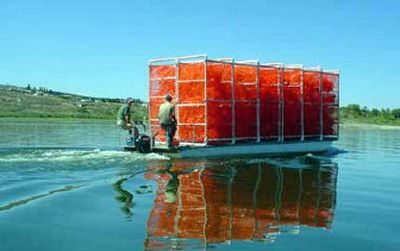Regulations changes, habitat work to boost Potholes Reservoir panfish

Times are changing at Potholes Reservoir, and fishing enthusiasts are in high gear as they try to adapt.
Water level management is changing. The underwater fish habitat is deteriorating. The composition of fish species is shifting.
Meanwhile, anglers are adjusting their fishing tactics, fish managers are proposing regulation changes and resort owners are launching a massive habitat rehabilitation project.
The sprawling reservoir south of Moses Lake continues to be a great place to go fishing. Bass anglers rank it as one of the hottest lakes in the state for catching largemouth and smallmouth bass. Walleye have proliferated in recent years and stocked rainbows grow to huge proportions in the fertile waters created by the Columbia Basin Irrigation Project in the 1950s.
But the desert vegetation inundated by irrigation runoff that accumulates behind O’Sullivan Dam has been decomposed and smothered under silt and Mount St. Helens volcanic ash. The loss of habitat appears to be one of the issues resulting in a decline of bluegills, perch and crappies that please anglers and feed the larger predatory species, according to Mike Meseberg of Mar Don Resort.
“Anybody who came here in the ‘60s, ‘70s and ‘80s remembers the incredible fishing for panfish,” said Meseberg, co-owner of the resort his family purchased 34 years ago. “With the combination of habitat loss and the increase in (predatory) walleyes, the crappies don’t have a chance to rebound.”
Meseberg said he’s been looking for answers to reversing the decline for nearly a decade. He thinks he hit the jackpot on a southward side trip from a vacation in Las Vegas.
“I met with the head of the Bureau of Land Management for the Lake Havasu project and he showed me how they have successfully restored their fishery, which had been devastated by the introduction of striped bass,” he said.
“The project we’ve started here at Potholes emulates the Havasu project.”
Last week, volunteers barged a load of 4-by-4-by-8-foot habitat boxes made of PVC pipe and synthetic fencing material. They anchored the boxes to the main reservoir bottom in the first stage of building artificial “reefs” that will accumulate food and create cover and forage for small fish.
“When the reservoir level is high, the water floods the willows in the sand dunes area to the north and the baitfish have all sorts of habitat,” he said. “But when the reservoir is drawn down in July and August, the little fish are really vulnerable.”
The Central Washington Fish Advisory Committee, which is deeply involved in Potholes and Moses Lake, has been issued state and federal permits to put up to 620 habitat boxes into the reservoir each year for 20 years, he said.
“Now all we need is more money to do it,” he added.
Using start-up grants totaling $25,000 from the state and other sources, volunteers have purchased materials for several hundred habitat boxes and other volunteers are signing up to build them, he said.
“We’re asking fishermen to donate and we have other volunteers looking for more funding sources,” he said.
Jeff Korth, Washington Department of Fish and Wildlife fisheries biologist, applauded the volunteer enthusiasm for the project.
“Theoretically it should help,” he said. “But as a state agency we can’t start something this ambitious without sound science to back it up. Unfortunately, we just don’t have the money to do the research.”
While volunteers are doing the habitat work, the department is proposing changes in the fishing regulations to keep the burgeoning walleye fishery from eating itself out of existence.
Proposals to be considered later this year by the Fish and Wildlife Commission would liberalize the walleye catch limit on Potholes, Moses and Sprague lakes to eight fish a day, up from the current five. The minimum size would be lowered to 12 inches and only one walleye over 22 inches would be allowed, he said.
Predation is considered one of the causes for the decline of panfish, but it’s not clear whether the driving factor is the increase in walleyes or the decrease of habitat, he said.
“The largemouth and smallmouth bass fishery is still great,” he said. “In fact, there’s so many smallmouth we’re proposing a more liberal limit to treat them more like panfish.”
The proposal calls for a daily smallmouth limit of 10 fish with one over 14 inches, he said.
At nearby Moses Lake, crappies have begun to rebound under strict catch limits imposed several years ago, Korth said. “But the bluegills still aren’t doing well even though we have almost Draconian regulations on them — a five-fish limit and 8-inch minimum.”
Liberalizing the walleye limit at Potholes and Moses lakes should attract more anglers to take out more of the prolific predators before they get big enough eat lots of panfish and reproduce, he said.
Meanwhile, the volunteers basing out of Mar Don Resort are digging in for the long run.
“We’ve already had at least 15 work parties and we’ve given free camping to Boy Scout groups that have come over to work,” Meseberg said.
“These habitat boxes are made to last and benefit the fishery for a long, long time. It’s not like the old method of sinking Christmas trees that would eventually deteriorate and leave a turpentine residue that repelled fish.
“We’re sure this is going to work, and the more help and donations we get, the faster it’s going to happen.”